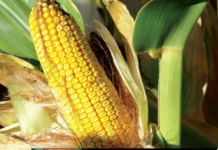Contact: Marsha Boswell, [email protected]
For audio version, visit kswheat.com.
Wheat Streak Mosaic Virus is a devastating disease in Kansas, and volunteer wheat in your field and all surrounding fields must be removed prior to planting. As farmers are currently drilling winter wheat across the state, be a good neighbor and control volunteer wheat. An infected field can impact thousands of acres in immediate proximity, depending on environmental factors.
The drought over the previous years, combined with multiple issues during harvest, have created conditions that make wheat streak mosaic and related diseases an increased threat this year. Abandoned wheat, weedy patches that weren’t harvested and hail-shattered fields all favor an increased incidence of volunteer wheat.
Wheat streak mosaic virus (WSMV) causes considerable damage to the Kansas wheat crop each year, primarily in the western portion of the state. In 2017, this disease caused a conservative $76.8 million in direct losses to wheat farmers, a loss of 19.2 million bushels of wheat. The 2017 loss was a 5.6 percent yield loss, up from an average 1.5 percent loss. For the past couple growing seasons, however, tests determine the disease showed up not only in western Kansas but also in central Kansas.
Wheat curl mites that spread WSMV and other diseases survive the summer on volunteer wheat and certain other grasses. As those plants die off, the wheat curl mites leave in search of new plants to feed on. Early planted wheat is likely to become infested and thus become infected with wheat streak mosaic virus, high plains virus and Triticum mosaic virus. The wheat curl mites are moved by wind and can be carried a mile or more before dying, so if wheat is planted early, make sure all volunteer wheat within a mile is completely dead at least two weeks before planting. For growers considering planting early, a good management consideration would be to select wheat varieties with resistance to the wheat streak mosaic virus and/or tolerance to the wheat curl mite, especially in the western portions of the state.
For more information on this devastating disease, download a packet of information or request a printed copy from Kansas Wheat, 1990 Kimball Ave., Manhattan, KS 66502.
We must work together to stop the spread of wheat streak mosaic virus and related diseases. There are no effective ways to treat, so the only way to stop it is to prevent it through one or more of the following ways.
Control Volunteer Wheat
The best way to prevent the spread of the wheat streak mosaic virus is to remove volunteer wheat and other grassy weeds. Volunteer wheat must be completely dead and dry for two weeks before planting a new wheat crop. Volunteer wheat and other grassy weeds can be removed with herbicides or tillage, but it’s absolutely essential to allow time for herbicides to work.
Avoid Early Planting
Avoid early planting; plant after the best pest management planting date, or BPMP (formerly known as the “Hessian fly-free”) date. By avoiding early planting, Kansas wheat farmers can avoid times when wheat mite populations are the highest in late summer and decrease the interval between planting and fall freeze events.
Plant Resistant Varieties
Plant varieties with moderate or high levels of resistance to WSMV. “Kansas Wheat Variety Guide 2023” is a new publication in the Kansas Wheat Rx Series and addresses steps to ensure a successful variety selection.
It is very difficult to rate varieties for WSMV. There are three separate virus diseases in the Central Plains that can all occur, separately or in combination: wheat streak mosaic virus, high plains virus and Triticum mosaic virus. They have similar symptoms and are vectored by the wheat curl mite. If two or more of these diseases occur together, all wheat varieties become susceptible.
At this point, there are no chemical options such as insecticides or pesticides that are effective at controlling the wheat curl mite. The best way to stop the spread of WSMV is to control volunteer wheat at least two weeks prior to planting a new crop.
###




